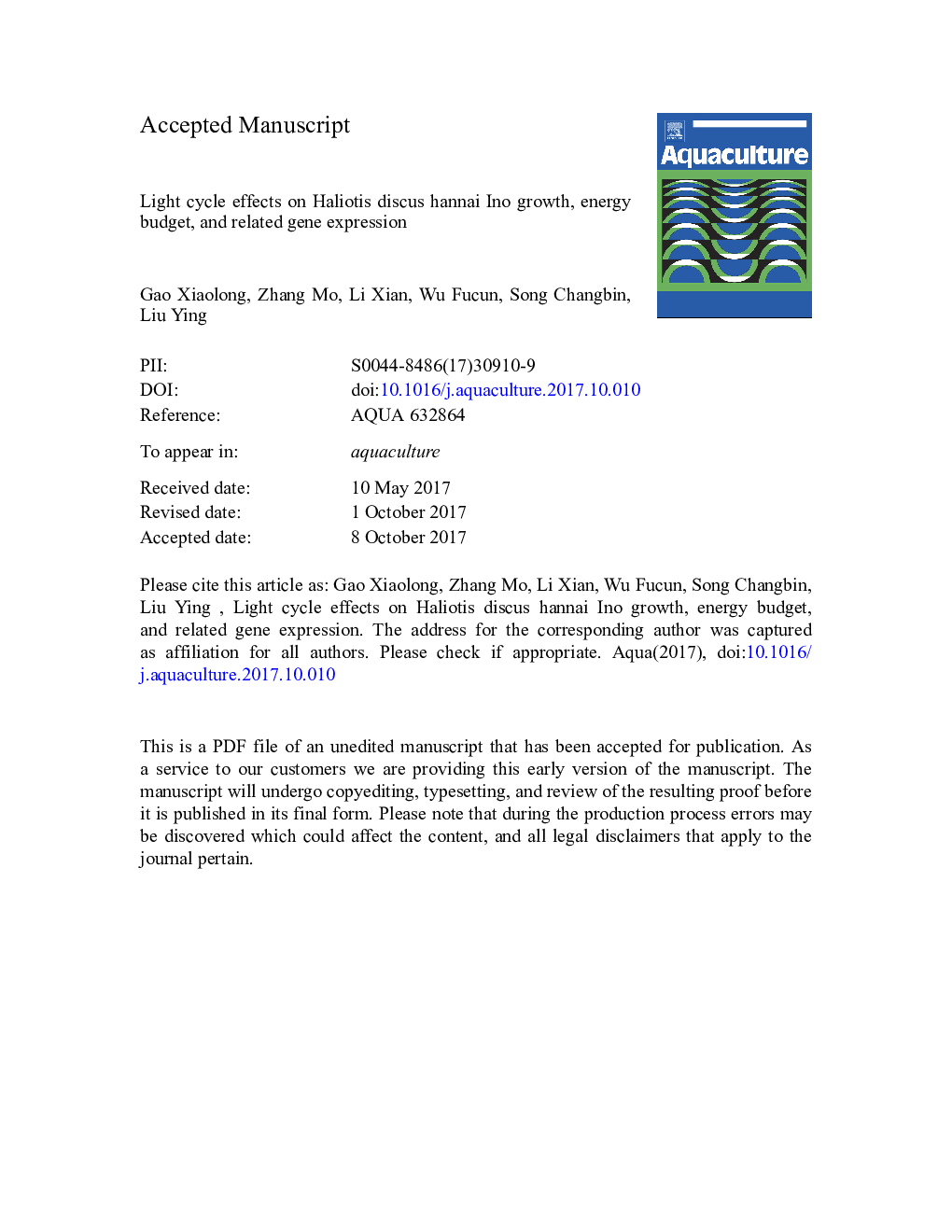| کد مقاله | کد نشریه | سال انتشار | مقاله انگلیسی | نسخه تمام متن |
|---|---|---|---|---|
| 8493616 | 1552805 | 2018 | 32 صفحه PDF | دانلود رایگان |
عنوان انگلیسی مقاله ISI
Light cycle effects on Haliotis discus hannai Ino growth, energy budget, and related gene expression
دانلود مقاله + سفارش ترجمه
دانلود مقاله ISI انگلیسی
رایگان برای ایرانیان
کلمات کلیدی
موضوعات مرتبط
علوم زیستی و بیوفناوری
علوم کشاورزی و بیولوژیک
علوم آبزیان
پیش نمایش صفحه اول مقاله

چکیده انگلیسی
This study investigated the effects of different light cycles on growth, food intake, energy budget, and related gene expression of the abalone Haliotis discus hannai Ino. Abalones (mean ± standard error shell length: 30.28 ± 1.64 mm, body weight: 4.51 ± 0.49 g) were exposed to the following light cycles: 0L:24D, 4L:20D, 8L:16D, 12L:12D, and 16L:8D for 60 days, four repetitions were provided for each light cycle. At the end of the experiment, there was no significant difference in shell length or body weight growth rate between 0L:24D and 4L:20D (P > 0.05), the values of which were significantly higher than in 16L:8D (P < 0.05). In 0L:24D, abalone food intake was significantly higher compared with in the other groups (P < 0.05), but the food conversion efficiency was significantly lower than in 4L:20D (P < 0.05). At the end of the experiment, in 16L:8D, the activity of hexokinase was significantly higher than in any other group (P < 0.05), but in 12L:12D and 16L:8D, it significantly increased compared with Day 30 (P < 0.05). In 0L:24D, 4L:20D, and 8L:16D, cellulase and pyruvate kinase activity was significantly higher than in 12L:12D and 16L:8D (P < 0.05). There was no significant difference in the energy acquired from food in 0L:24D and 4L:20D (P > 0.05). However, the energy loss via feces and respiratory metabolism in 0L:24D was significantly higher than in 4L:20D (P < 0.05); therefore, the energy accumulated for individual growth was significantly lower than in 4L:20D (P < 0.05). Although the energy loss via feces, excretion, and respiratory metabolism was significantly lower in 16L:8D compared with 0L:24D, 4L:20D, and 8L:16D, the ratio of the energy loss via feces and respiratory metabolism to the energy acquired from food intake was significantly higher than in any other group (P < 0.05); therefore, the net growth efficiency K2 was significantly lower (P < 0.05). In 16L:8D, gene expression levels of manganese superoxide dismutase (Mn-SOD), catalase (CAT), TPx, heat shock protein (HSP) 26, HSP70, and HSP90 were significantly higher than in any other group (P < 0.05). At the end of the experiment, Mn-SOD, CAT, and HSP70 expression in 16L:8D significantly increased compared with Day 30 (P < 0.05). Therefore, considering aquaculture production and business costs, it would be appropriate to select the light cycle of 4L:20D for the culture of H. d. hannai.
ناشر
Database: Elsevier - ScienceDirect (ساینس دایرکت)
Journal: Aquaculture - Volume 483, 20 January 2018, Pages 213-222
Journal: Aquaculture - Volume 483, 20 January 2018, Pages 213-222
نویسندگان
Gao Xiaolong, Zhang Mo, Li Xian, Wu Fucun, Song Changbin, Liu Ying,